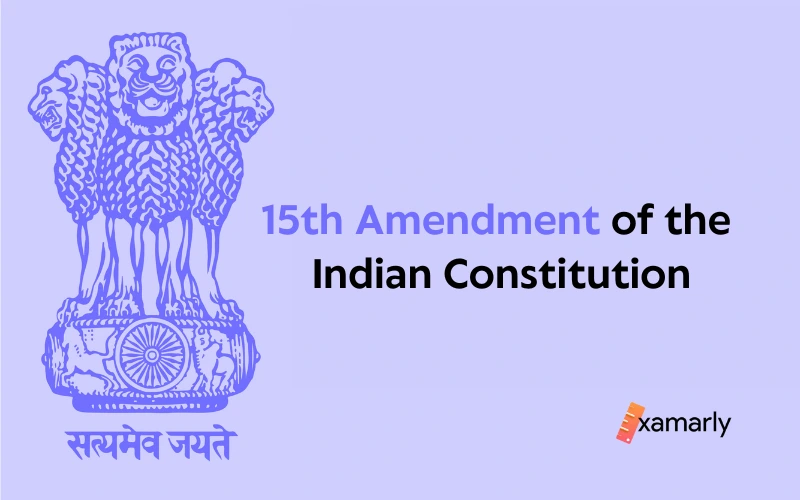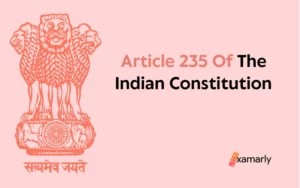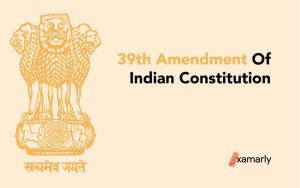Indian Polity is an important subject from the UPSC exam point of view. Here you are made familiar with the several constitutional amendments of the Indian Constitution. In this blog, one such important constitutional amendment is discussed.
The 15th Amendment of the Indian Constitution proposed amending Article 217 of the Indian Constitution. The judges of the High Court were thus able to retire at sixty-two years of age instead of sixty. The retiring High Court judge was allowed to serve as an ad-hoc judge of the Supreme Court by a revised version of Article 128 of the Indian Constitution.
Additionally, the change offered a compensation allowance to judges migrating from one High Court to another, by the new clause of Article 222 of the Indian Constitution.
Read this article further to learn more about the changes done by the 15th Amendment of the Indian Constitution.
Also, you will understand the reason behind the need for such an amendment and other relevant information. This blog will be worth reading if you are preparing for a competitive examination like UPSC. This is included in the Indian Polity of UPSC Syllabus.
- 15th Amendment of the Indian Constitution: Explained
- Statement of Objects and Reasons
- Major provisions
- Conclusion
- FAQs related to the 15th Amendment of the Indian Constitution
- When was the 15th Amendment of the Indian Constitution enacted?
- What was the bill that held the Statement of Objects and Reasons for the enactment of the 15th Amendment of the Indian Constitution?
- Who introduced the bill for the enactment of the 15th Amendment of the Indian Constitution?
- When was this bill passed?
- Which Schedule of the Indian Constitution was amended by the 15th Amendment of the Indian Constitution?
15th Amendment of the Indian Constitution: Explained
The 15th Amendment of the Indian constitution was passed in 1963. The Constitution (Fifth Amendment) Act, 1963, may be used to refer to this legislation.
The High Court can now issue writs to any individual, Government, or authority even those outside of their geographical jurisdiction, if the cause of action originates inside the territorial boundary, thanks to the 15th Amendment of the Indian Constitution.
With the amendment of provisions of Article 217, high court judges must now retire at sixty-two years of age rather than sixty.
This amendment also outlined the process for figuring out the judges’ ages on the Supreme Court and the High Court. Judges who are transferred from one High court to another must get compensation, according to new clause (2) of Article 222.
Also Read: 14th Amendment of the Indian Constitution
Statement of Objects and Reasons
The Constitution has been subject to many proposed amendments over the years. The Constitution (Fifth Amendment) Bill was presented to the Lok Sabha. This was done in November of 1955 to make some of them effective.
The Bill was unable to move forward for a variety of reasons. Everything else, with the exception of the one relating to the amendment of Article 3 of the Constitution, was allowed to expire. The Constitution (Fifth Amendment) Act of 1955 made a distinct amendment to this article.
Some of the provisions from the Constitution (Fifth Amendment) Bill are contained in the current Bill. There are a few more proposals for amendment to the Constitution as well.
The Constitution (Fifth Amendment) Bill included amendments to Article 276, Article 297, Article 311, and Article 316 of the Indian Constitution. The modifications have been made to these articles with a few minor modifications.
In addition to entry 78 of the Union List, the proposed amendments also impact Article 124, Article 128, Article 217, Article 220, Article 222, Article 224A, and Article 226 of the Indian Constitution.
The High Court judge’s age of retirement was changed under Article 217. It was revised from sixty to sixty-two years. The President must make a decision whenever there is a dispute over a judge of the Supreme Court or a High Court’s proper age. A precise provision in Article 124, as well as Article 217, is suggested in order to articulate the decision.
Judges should be moved from one High Court to another, only if it is deemed to be in the public’s interest and by consensus.
The Judge who is so transferred might anticipate facing an increased financial burden as a result of this move. Therefore, it is suggested that he get a compensatory allowance in addition to his wage.
The provision of Article 220 provides that a Judge who is transferred from one High Court to another is not allowed to reopen his legal firm in any of the High Courts where he previously served as a Judge. As a result, the provisions of Article 220 put a stop to any request to transfer a High Court judge.
It is therefore proposed to amend Article 220. The revision was needed so that the restriction regarding the resumption of practice should apply only to the High Court from which the Judge retires. This provision would only apply if the Judge had served in that High Court for at least five years immediately prior to retirement
Transfer of judges would be made easier by such a clause. The Punjab High Court is the sole High Court that has jurisdiction with respect to the Central Government, according to the current wording of Article 226 of the Constitution.
The other new recommendations are of a minor character.
Major provisions
- Amendment of Article 124– In Article 124, a new clause (2A) was added. The age requirement for serving as a judge on the Supreme Court will be set by such power and in such way as Parliament may by legislation prescribe.
- Amendment of Article 128- A revised version of Article 128 allows for the appointment of a retired judge from a High Court to serve as a judge of the Supreme Court.
- Amendment of Article 217- By an amendment to Article 217, Clause (1), a High Court Judge’s retirement age has been raised from 60 to 62. With retroactive effect, a new clause (3) was added to Article 217. That allows the President to decide the age of a judge of a High court after consulting with the Chief Justice of India.
- Amendment of Article 222- A new clause (2) is added to Article 222 that states that judges who are transferred from one high court to another must receive a compensatory allowance.
- Amendment of Article 224- A new article 224A is introduced. It allows for the appointment of a former High Court judge to serve as a High Court judge with the previous consent of the President.
- Amendment of Article 226- Article 226 was amended to include clause (1A). It states that the High Court, whose territorial jurisdiction the cause of action originates under, may also have the ability to issue directives, orders, or writs to any government, authority, or person, even if their seat or place of abode is beyond the high court’s territorial jurisdiction.
- Amendment of Article 297- In the revised version of Article 297, the phrase “or the continental shelf” will be added. This addition would follow the words “territorial waters” from the previous version of the article.
- Amendment of Article 311- In particular, new clauses to Article 311 are introduced in place of the existing clauses (2) and (3). This was done to ensure that any civil servant facing a proposed action of dismissal, removal, or reduction in rank on the ground of conduct is informed of the charges and given a reasonable opportunity to be heard at the inquiry stage. But, when the action is taking place, the civil servant’s reasonable opportunity would be limited to making a representation based on the evidence presented.
- Amendment of Article 316- Revised version of Article 316 inserts a new clause (1A). As a result, a Public Service Commission may select an acting chairman when the regular chairman is absent, on leave, or otherwise unable to perform his duties.
- Amendment of the Seventh Schedule– In the Seventh Schedule, Entry 78 in List 1 has been changed to clarify that “vacations” is included in the definition of “organization” there.
To read the Statement of Objects and Reasons in greater detail, click here.
Conclusion
Through this blog for UPSC preparation, you learnt that the High Court has the power to issue writs or directions to any Government, person, or organization, even if their seat or place of residence is outside of those territories, so long as the cause of action originated there, thanks to the 15th Amendment of the Indian Constitution.
This amendment also allows High court judges to retire at age 62 as opposed to 60, and also outlined the process for determining the age of judges of the High Court and Supreme Court.
You Might Also Like: 16th Amendment of the Indian Constitution
FAQs related to the 15th Amendment of the Indian Constitution
When was the 15th Amendment of the Indian Constitution enacted?
October 5, 1963.
What was the bill that held the Statement of Objects and Reasons for the enactment of the 15th Amendment of the Indian Constitution?
The Constitution (Fifteenth Amendment) Bill, 1962.
Who introduced the bill for the enactment of the 15th Amendment of the Indian Constitution?
A. K. Sen.
When was this bill passed?
November 14, 1962.
Which Schedule of the Indian Constitution was amended by the 15th Amendment of the Indian Constitution?
Seventh Schedule of the Indian Constitution.






